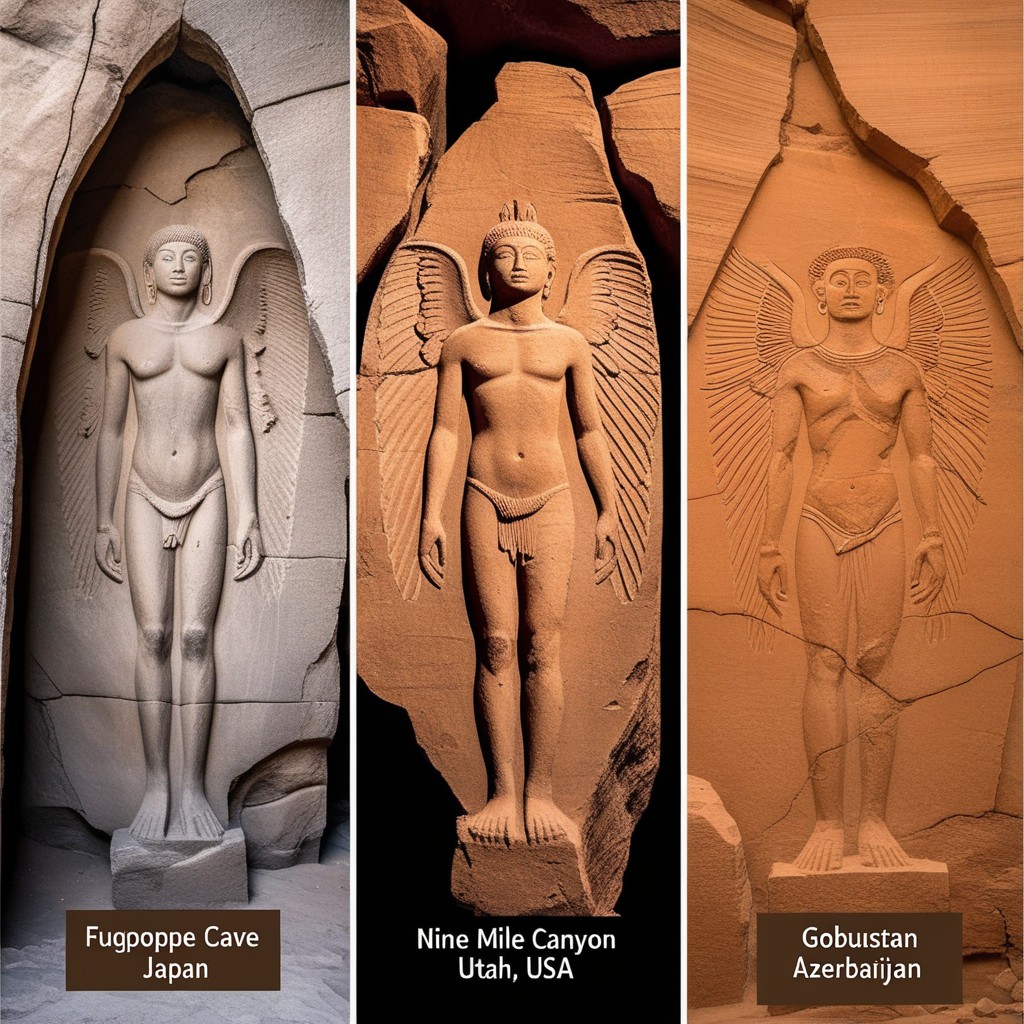
Throughout history, human societies have left their mark on the world in the form of ancient carvings, or petroglyphs, which provide a window into the beliefs, stories, and experiences of our ancestors. Among the most intriguing of these ancient carvings are the nearly identical depictions of winged or flying figures found in vastly distant locations: Fugoppe Cave in Japan, Nine Mile Canyon in Utah, USA, and Gobustan in Azerbaijan. The striking similarities between these petroglyphs have sparked a global conversation, raising questions about the possibility of shared cultural motifs or ancient connections that spanned continents.

A Closer Look at the Petroglyphs
1. Fugoppe Cave, Japan 🇯🇵
The petroglyphs in Fugoppe Cave are believed to date back approximately 7,000 years. These ancient carvings feature human-like figures with wing-like appendages, suggesting representations of divine or supernatural beings. The cave itself, nestled in the northern part of Japan, is a treasure trove of ancient art, with numerous carvings that seem to depict spiritual or shamanic practices. The winged figures have long intrigued archaeologists, prompting theories about their significance in early Japanese mythology.
2. Nine Mile Canyon, Utah, USA 🇺🇸
Located in the heart of Utah, Nine Mile Canyon is often referred to as the “world’s longest art gallery” due to its extensive collection of Native American rock art. The winged figures found here are estimated to be between 1,000 and 2,000 years old, created by the Fremont culture or the Ute people. These carvings feature anthropomorphic figures with outstretched limbs, seemingly adorned with wings or feathers. Scholars believe these could represent spiritual beings, messengers, or even shamans in a state of transformation.
3. Gobustan, Azerbaijan 🇦🇿
The rock carvings of Gobustan, a UNESCO World Heritage site, are some of the oldest known, dating back up to 10,000 years. Among the many petroglyphs in this region are depictions of human figures with wing-like extensions. The exact meaning of these carvings remains a mystery, but they are believed to represent mythological beings or ancient deities associated with flight. Gobustan’s extensive petroglyph collection provides a glimpse into the lives and beliefs of prehistoric people who inhabited the Caspian Sea region.
Theories Behind the Shared Motif
The recurring theme of winged figures across these distant cultures raises several fascinating questions. How did such similar iconography appear in places separated by thousands of miles? Several theories attempt to explain this phenomenon:
1. Shared Mythological Framework:
One possibility is that these ancient societies developed a similar mythological framework independently. The depiction of winged beings could symbolize spiritual entities, deities, or ancestors who were believed to have the power of flight or transcendence. The motif of flight has deep roots in many ancient cultures, often associated with freedom, divinity, and the sky.
2. Ancient Cultural Interactions:
Another theory suggests that these distant civilizations might have been influenced by shared cultural exchanges. Ancient trade routes, such as the Silk Road, could have facilitated the transmission of ideas, symbols, and beliefs across vast distances. Although direct contact between these specific regions is not well-documented, the possibility of indirect influences cannot be ruled out.
3. Universal Human Experience:
The most straightforward explanation could be the universality of human imagination and experience. Early humans across the globe looked up at the sky, observed birds in flight, and envisioned beings that could transcend earthly boundaries. The desire to represent these powerful, otherworldly figures might have led to the creation of similar symbols across different cultures independently.
The Significance of Winged Figures
The winged figures in these petroglyphs are often interpreted as representations of spiritual beings, deities, or shamans. In many ancient cultures, wings were symbolic of divine power and the ability to travel between the earthly realm and the heavens. They could represent messengers from the gods or even ancestors who had gained the power of flight in the afterlife. The presence of these figures in ancient carvings suggests a shared fascination with the concept of flight and its association with spirituality and transcendence.
The Ongoing Mystery
Despite extensive research, the mystery behind these petroglyphs remains unsolved. The similarities between the carvings in Japan, Utah, and Azerbaijan continue to captivate archaeologists, historians, and enthusiasts alike. Are these depictions merely coincidental, or do they point to a deeper, ancient connection between early human societies? The answer may lie buried in the stories of our ancestors, waiting to be uncovered through further exploration and study.
What is clear, however, is the incredible significance of these carvings. They serve as a testament to the creativity, spirituality, and complex belief systems of ancient peoples. The shared imagery of winged beings across such diverse regions hints at a common thread in human consciousness, one that sought to depict the mysteries of life, death, and the divine.
Conclusion
The petroglyphs of Japan, Utah, and Azerbaijan offer a glimpse into a shared human experience that transcends time and geography. These ancient carvings challenge our understanding of early human societies and their interactions. Whether they represent a universal symbol or evidence of ancient cultural connections, the winged figures carved into stone thousands of years ago continue to spark curiosity and inspire wonder in modern observers.
As we uncover more about these ancient artworks, we may come closer to understanding the mysteries of our shared human past. Until then, the enigmatic winged beings will remain a powerful symbol of the unknown, etched into the rock faces of our world, silently telling their stories to those who seek to listen.